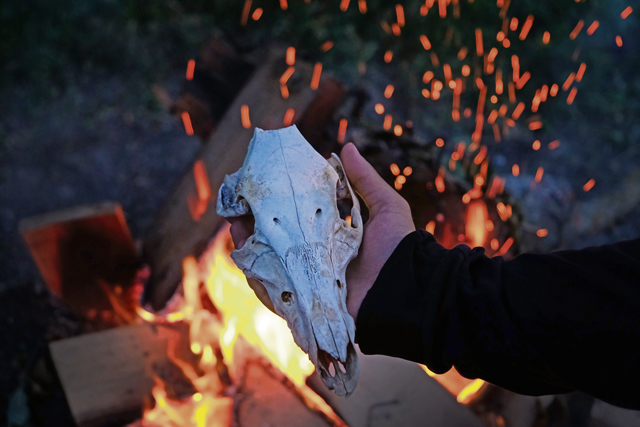
Ghosts and goblins, spiders and witches, trick-or-treating, jack-o-lanterns, and spooky parties? We are all familiar with typical Halloween scenes and activities. But, have you ever wondered where the tradition originated and how it was brought across the Atlantic Ocean and then back to Europe in the last century?
The celebration on the last day of October has a rich history that dates back over 2,000 years to the ancient Celtic festival of Samhain (pronounced “sow-win”). The festival marked the end of the harvest season and the beginning of winter, a time often associated with death. The Celts, who lived in what is now Ireland, the United Kingdom, and northern France, believed that on the night of Oct. 31, the boundary between the living and the dead became blurred, allowing spirits to return to earth.
During Samhain, Celts would extinguish their hearth fires and gather to light a communal bonfire, which was believed to ward off evil spirits. They wore costumes, typically made from animal heads and skins, to disguise themselves from the spirits. Offerings of food and drink were left outside to appease the wandering spirits and ensure a good harvest for the coming year.
Ancient Celts marked Samhain as the most significant of the four quarterly fire festivals, taking place at the midpoint between the fall equinox and the winter solstice. During this time of year, hearth fires in family homes were left to burn out while the harvest was gathered.
After the harvest work was complete, celebrants joined with Druid priests to light a community fire using a wheel that would cause friction and spark flames. The wheel was considered a representation of the sun and used along with prayers. Cattle were sacrificed, and participants took a flame from the communal bonfire back to their home to relight the hearth.
It is also noted that in some areas Samhain was a mandatory celebration lasting three days and three nights where the community was required to show themselves to local kings or chieftains. Failure to participate was believed to result in punishment from the gods, usually illness or death.
There may have also been a military aspect to Samhain in Ireland, with holiday thrones prepared for commanders of soldiers. Anyone who committed a crime or used their weapons during the celebration faced a death sentence.
As the Roman Empire expanded into Celtic territories, Samhain traditions began to merge with Roman festivals. By the 9th century, the influence of Christianity had spread into Celtic lands. Pope Gregory III designated Nov. 1 as All Saints’ Day, a time to honor saints and martyrs. The evening before became known as All Hallows’ Eve, eventually shortened to Halloween.
Halloween was brought to the United States by Irish and Scottish immigrants in the 19th century. These immigrants carried with them the traditions of Samhain and All Hallows’ Eve. In America, Halloween evolved into a community-centered holiday, with activities such as trick-or-treating, costume parties, and pumpkin carving becoming popular. Although Samhain, or Halloween, originated in Europe, it was reintroduced to many European countries from the United States in the late 20th century.
Today, Halloween in Ireland is celebrated with a mix of traditional and modern festivities. Some of the highlights include the Púca Festival in County Meath, which celebrates the mythological Púca, a shape-shifting creature from Celtic folklore. The event features music, myth, food, folklore, and fire. The Macnas Parade in Galway along the West Coast is a spectacular event with giant puppets, performers and musicians taking to the streets. The Bram Stoker Festival in Dublin celebrates the legacy of the author of “Dracula’ with gothic-themed events, performances and installations.
Halloween celebrations have become very popular in Germany, and you may experience children trick-or-treating in costume in your village. Traditions such as costume parties, haunted houses and even parades are gaining popularity among adolescents and young adults, in particular, in view of the German holiday the following day.
A few special events to let your blood run cold: Europa Park invites visitors to Horror Nights – Traumatica, a festival of fear. The event will provide plenty of shock effects and nasty nightmares. Cruel creatures, monsters and dark figures will spread fear and terror.
Or, spend Halloween at Castle Satzvey: Ghostly creatures will crawl out of every corner of the extensive castle grounds and terrify anyone who approaches. A particular horror highlight is the course of terror in the dark castle park – definitely not for the faint-hearted! A child-friendly program starts at 3 p.m., but at 6 p.m. a spooky ferryman will greet visitors at the lake. For the braver, a disco will begin at 10 p.m.
What would the season be without bright round orange pumpkins as floral decoration, spooky jack-o-lanterns or picking your own pumpkin at one of the large pumpkin farms in the area? Use your last chance to visit the pumpkin exhibit at Gartenschau in Kaiserslautern, with this year’s motto “jungle book,” not quite so scary, but ideal for children.
The zoo in Siegelbach has a special “spooky night” for younger visitors on Oct. 31 and the Celtic village at Donnersberg will again host its annual Samhain festival with bonfires, Celtic arts and crafts and a torch walk to the circle of statues in its Celtic Garden in the evening.
Whatever you decide to do, whether it’s carving pumpkins with your kids, spending a blood-chilling time at a haunted house or castle, watching a scary movie, or just rushing to the door every few minutes to cater to trick-or-treaters, make sure to have a spooky weekend and an eerie Halloween night! Boo!


